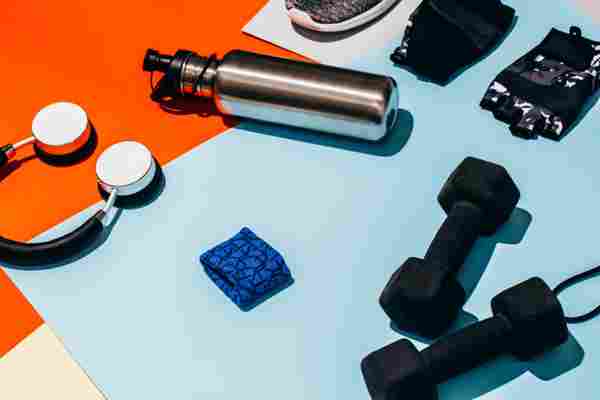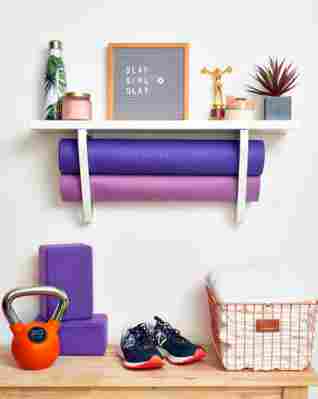
Since the pandemic began, many homeowners have avoided the gym. This is for safety reasons, of course: It’s a good idea to avoid crowded places where sweaty people are panting beside you. Some other upsides to working out at home? Saving you time (no commute!) and money (no membership fees). Maybe, like many others this year, you’ve invested in a full fitness area in your basement, garage, or in an extra bedroom, or have made your living room do double-duty as a yoga studio or cardio hot spot to stay healthy.
But if you’re planning to put your house on the market anytime soon, take a closer look at that pile of workout stuff. Depending on your neighborhood, style of home, and setup, a home gym may or may not add value to your property. Two real estate experts weigh in on how to make sure your home gym scores with potential buyers.
1. Make sure it’s clear that it’s meant to be used as a gym.
If you’re going to leverage a home workout space in your listing, make sure you have a dedicated space that clearly shows its purpose, says Nora Crosthwaite, a licensed real estate agent at Stagerie , an online staging marketplace in Des Moines, Iowa.
“To fully qualify as a home gym, I would look for mats on the floors,” says Crosthwaite. “If it’s in the basement, I’d want to see a finished basement room with some natural light.”
2. Outfit it with all the essentials.
A home gym should have essential equipment for cardio and weight training, plus mats to stretch, do abdominal work, and yoga or Pilates. You may also want a bench, dumbbell rack, and a TV if you want to join an online class. A wireless sound system with built-in speakers also comes in handy.
3. Keep it as separate from other living spaces as possible.
Workout equipment can be an eyesore, plus it can overpower a space, making it appear smaller. Setting up your gear in a main living space is never ideal. You don’t want buyers thinking their furniture couldn’t possibly fit in the house, right? Instead, put the gym in the basement or garage, and not a bedroom, says Bill McGoldrick , a licensed real estate agent with Realty Associates of Atlanta.
“The gym needs to be a separate space away from other more formal living spaces and it shouldn’t take away from the number of traditional bedrooms,” he says.
4. Only turn a bedroom into a gym as a last resort.
Your bedroom-into-gym conversion would likely lower the resale value unless your home has at least five bedrooms, he adds. Buyers will be turned off if one of the two bedrooms in the home is jammed with cardio equipment.
5. Any other empty or under-used room, though, is a great spot.
Have a totally unused bonus room? That can be a great spot for a home gym, too. After all, buyers need to clearly see a space’s purpose, says Crosthwaite.
“People almost always have difficulty imagining what they could do in an empty room, especially a smaller room,” she says.
6. What to do with that spare bedroom, then? Turn it into a yoga space.
A yoga or meditation space works especially well in a spare bedroom, she adds.
“Add a yoga mat plus some plants for a more cost-effective way of staging the room than putting in bedroom furniture.”

7. Think about the flow and overall vibe of the room.
Ever notice how nice hotel gyms are? Steal some of those vibes when designing your space. Paint walls a soft, neutral shade, add some bright lighting, and hang up some colorful art. Arrange large machines so the traffic flow works well. Make sure to store hand weights, resistance bands, and kettle bells neatly off the floor.
“Buyers who care about home gyms will want to see that yours is set up well, not just thrown together, so make sure it’s organized and clean, and that every piece looks intentional,” says Crosthwaite.
8. If you have heavy apparatuses, put them on a lower floor.
Using treadmills or elliptical trainers? The safest bet is to set up your home gym at the lowest level of your home, and on a concrete slab floor, says McGoldrick.
“A wood-framed floor may cause any pounding or impact to resonate through the home,” he explains.
9. And if you can, opt for rubber tiles as flooring.
“In order to really add value, it should have a rubber tiled floor as well,” McGoldrick adds.
10. Don’t forget about the ventilation and power needs.
“Buyers will want to know the gym is adequately ventilated, has enough windows to make working out fun, and also has the right outlets to plug in equipment,” Crosthwaite says.
11. Forget adding floor-to-ceiling mirrors on the walls.
“Buyers who don’t need or want a home gym would consider that to be a negative feature that they would want to remove,” cautions McGoldrick.

Leave a Reply